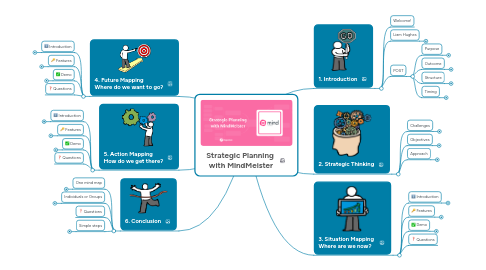
1. 4. Future Mapping Where do we want to go?
1.1. Introduction
1.1.1. Based on where we are today...
1.1.1.1. What should our goals be?
1.1.1.2. How will we know if we're there?
1.1.2. (OKR) Objectives & Key Results
1.1.2.1. Objective: Aspiration
1.1.2.2. Key Results: Analytics
1.1.2.2.1. Think "As measured by..."
1.1.2.3. (These are hard)
1.1.3. Considerations
1.1.3.1. Timeframe
1.1.3.1.1. Next quarter
1.1.3.1.2. Next 6 months
1.1.3.1.3. Next year
1.1.3.2. Larger business/organisation plans
1.1.3.3. 2 for 1 opportunities
1.1.3.3.1. One goal that addresses more than one "Top 3" item
1.2. Features
1.2.1. Progress icons
1.3. Demo
1.3.1. Start: Prioritised Map
1.3.1.1. Add an OKR branch
1.3.1.2. How to convert Top 3 into an objective?
1.3.1.3. How would you measure this?
1.3.2. End: SWOT + OKRs
1.4. Questions
2. 5. Action Mapping How do we get there?
2.1. Introduction
2.1.1. Connecting big picture with daily work
2.1.1.1. Big picture: The business
2.1.1.2. Daily work: What this means for ME
2.1.2. What actions get us there?
2.1.2.1. Stop
2.1.2.2. Start
2.1.2.3. Do More
2.1.2.4. Do Less
2.1.3. We know the big picture
2.1.3.1. Our current situation (SWOT)
2.1.3.2. Our desired future (OKR)
2.1.4. Monitor and Review
2.1.4.1. Day to day
2.1.4.2. Quarter to quarter
2.2. Features
2.2.1. Task info
2.2.1.1. Assign dates
2.2.1.2. Assign to people
2.2.2. Search
2.3. Demo
2.3.1. SWOT + OKR + Actions
2.4. Questions
3. 6. Conclusion
3.1. One mind map
3.1.1. From big picture thinking (SWOT)
3.1.2. To future state planning (OKRs)
3.1.3. To next day actions (Action Mapping)
3.2. Individuals or Groups
3.2.1. Individuals
3.2.1.1. Take your time
3.2.1.2. Take breaks and come back
3.2.2. Groups
3.2.2.1. Individuals-Pairs-Group
3.2.2.1.1. Think individually
3.2.2.1.2. Compare in pairs
3.2.2.1.3. Feed into group mind map
3.3. Questions
3.4. Simple steps
3.4.1. Not overly-complicated
3.4.2. Not intellectualised
3.4.3. Simple prompts get you far
4. 1. Introduction
4.1. Welcome!
4.2. Liam Hughes
4.2.1. Founder: Biggerplate.com
4.2.2. Many strategic sessions!
4.2.2.1. High intensity
4.2.2.2. Group facilitation
4.2.2.3. Mind map driven
4.2.3. Connect
4.2.3.1. Biggerplate.com/LiamHughes
4.2.3.2. Twitter: @BiggerplateLiam
4.2.3.3. Linkedin
4.2.3.4. Email: Liam@Biggerplate.com
4.3. POST
4.3.1. Purpose
4.3.1.1. Walkthrough a strategic thinking and planning process using MindMeister
4.3.1.2. (What we do at Biggerplate, and with clients)
4.3.2. Outcome
4.3.2.1. Replicable approach for you to try
4.3.2.2. Essential MindMeister knowledge
4.3.3. Structure
4.3.3.1. This map
4.3.3.2. Each section
4.3.3.2.1. Introduction
4.3.3.2.2. Features
4.3.3.2.3. Demo
4.3.3.2.4. Questions
4.3.4. Timing
4.3.4.1. 90 Minutes
5. 2. Strategic Thinking
5.1. Challenges
5.1.1. Time pressures
5.1.1.1. Finding time to pause
5.1.1.1.1. Too busy doing
5.1.1.1.2. No time to look up/around
5.1.1.2. The rush to action
5.1.1.2.1. Moving fast
5.1.1.2.2. But wrong direction...
5.1.1.2.3. "Fire, ready, aim"
5.1.2. Perceptions of 'Strategy'
5.1.2.1. "Not my job"
5.1.2.2. "For people at top"
5.1.2.3. "I'm not strategic"
5.1.2.4. Quote: "Leave it to the MBAs"
5.1.3. Over-complication
5.1.3.1. Going too deep/analytic
5.1.3.2. Too much information
5.1.3.3. Non-human speak
5.1.3.4. Lack of priorities/outcomes
5.1.4. Connecting macro & micro
5.1.4.1. Big picture thinking vs day-to-day
5.1.4.2. Turning ideas into action
5.1.4.3. What does it mean for me...?
5.2. Objectives
5.2.1. Simplify 'strategy'
5.2.1.1. Think broader
5.2.1.2. Engage others
5.2.1.2.1. (Create ownership)
5.2.2. Connect macro and micro
5.2.2.1. Big picture view
5.2.2.2. Your daily working
5.2.2.3. Connected priorities
5.2.3. Diverge-Explore-Converge
5.2.3.1. Ref: Gamestorming
5.2.3.1.1. Diverger: Think big picture
5.2.3.1.2. Explore: Build understanding
5.2.3.1.3. Converge: Priorities, Objectives, Actions
5.3. Approach
5.3.1. Situation Mapping
5.3.1.1. Where are we today?
5.3.2. Future Mapping
5.3.2.1. Where do we want to go?
5.3.3. Action Mapping
5.3.3.1. How do we get there?
6. 3. Situation Mapping Where are we now?
6.1. Introduction
6.1.1. Aim: Pause to review current situation
6.1.2. What we need
6.1.2.1. A simple prompt for thinking
6.1.2.2. Applicable at any level
6.1.2.2.1. My whole organisation
6.1.2.2.2. My team/division
6.1.2.2.3. Myself, my career
6.1.2.2.4. Specific product/category
6.1.2.3. Many options
6.1.2.3.1. SWOT
6.1.2.3.2. PESTLE
6.1.2.3.3. SCORE
6.1.2.3.4. Super Simple
6.1.3. Example: SWOT
6.1.3.1. Stands for...
6.1.3.1.1. Strengths
6.1.3.1.2. Weaknesses
6.1.3.1.3. Opportunities
6.1.3.1.4. Threats
6.1.3.2. Benefits
6.1.3.2.1. Very simple framework
6.1.3.2.2. Don't need 'strategic'
6.2. Features
6.2.1. Basic map building
6.2.1.1. Adding topics
6.2.1.1.1. Insert
6.2.1.1.2. Return
6.2.1.2. Moving/edit
6.2.2. Icons/Images
6.2.3. Extra info
6.2.3.1. Notes
6.2.3.2. Hyperlinks
6.3. Demo
6.3.1. Capture
6.3.1.1. Basic brainstorm
6.3.1.2. Demo
6.3.1.2.1. Start: Blank Map
6.3.1.2.2. Finish: Big List Map
6.3.2. Categorise
6.3.2.1. Identify Categories
6.3.2.2. What belongs together?
6.3.2.3. Continue building/refining
6.3.2.3.1. Anything else to add?
6.3.2.3.2. Can we refine?
6.3.2.4. Demo
6.3.2.4.1. Start: Big List Map
6.3.2.4.2. Finish: Categorised Map
6.3.3. Prioritise
6.3.3.1. Top 3 Thinking
6.3.3.1.1. Distil/summarise
6.3.3.1.2. Make visual
6.3.3.2. Demo
6.3.3.2.1. Start: Categorised Map
6.3.3.2.2. Finish: Top 3 Map
